 Loading... Please wait...
Loading... Please wait...Free Shipping on orders over $500
Categories
Blog - ECG Machine
EKG Machine and ECG Machine Buyer's Guide For Medical Professionals
Posted on 07/06/2018 09:58:41
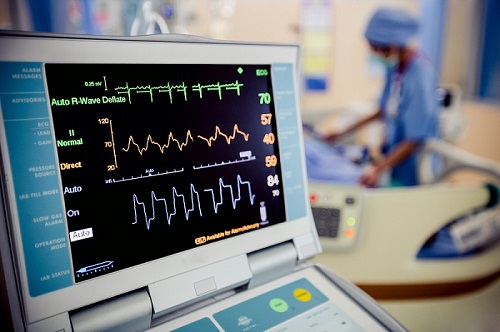
Purchasing an EKG/ECG machine can be a major investment, especially for new or smaller medical facilities. Perhaps your current ECG machine is near the end of its lifecycle. If your office, hospital or clinic is expanding, you’ll have a need to acquire additional machines. When considering the purchase of an EKG machine, you want a device that works best for you–functionally and financially. Finding the right machine for your specific needs can save costs, boost office workflow, and improve patient care.
Should you buy a new ECG machine? Do you need an interpretive or non-interpretive model? How portable does it need to be? Does it need to connect with other equipment? How much does an EKG machine cost? What will the supplies and accessories cost? These are important questions to ask when making a purchase decision. The most important consideration, though, is finding a reliable and affordable ECG system that fits your needs.
Purchase options and considerations
- Understanding the ECG Machine
- Choosing your ECG Machine
- Standard 123-Lead ECG Machines
- 12-Lead ECG Machines with Spirometry
- Stress ECG Machines
- Holter Wearable ECG Monitors
- ECG Machine Accessories
- How to maintain ECG Machines
- Where to Buy an ECG Machine
This guide will help you understand the basics, help you find the right EKG machine for sale and help enable you to make the best possible purchase decision.
What is an EKG Machine? A quick look back
In 1901, Willem Einthoven, a Dutch physician, invented the first practical electrocardiograph using a string galvanometer. Einthoven received the Nobel Prize in Medicine in 1924 for his electrocardiography work.
In 1927 the General Electric Company (GE) developed its own version of the ECG machine using amplifier vacuum tubes with a lamp and mirror that traced electrical impulses onto film.
Using the same basic principles of those early machines, today’s devices have evolved into compact solid-state systems. There are portable EKG machines light enough to be easily carried from room to room. Some feature computer-aided interpretation of normal and abnormal EKG results. Many have integrated printers and high-resolution LCD touch-screens. Some are even wearable, making today’s models faster and more portable than ever before.
ECG vs EKG: What’s the difference?
You may have noticed that ECG is often spelled EKG. Many people wonder, What's the difference between ECG and EKG? The different spellings make it seem as if they are two different machines.
However, it's important to note that ECG and EKG are used interchangeably and mean exactly the same thing. The difference is simply a result of how the word "electrocardiogram" is translated. The machine was invented in the early 1900s by Willem Einthoven, a Dutch doctor and medical researcher. His electrocardiogram became known as the ECG in many parts of the world, but when the electrocardiogram was translated into German, it was spelled elektrokardiogramm. This led to the widely-used abbreviation EKG.
Today, ECG and EKG are both commonly used by medical professionals around the world. While most English-speaking countries may tend to use ECG more than EKG, there is no right or wrong way to abbreviate the electrocardiogram. For this reason, both terms are used in this article.
How an ECG Machine works
Your heart beats when an electrical impulse is sent from the sinoatrial node (SA node) located in the right atrium of the heart. These signals function like a natural pacemaker and help the heart maintain a steady pace. The electrical activity originating in the heart is created by the diffusion of calcium, sodium and potassium ions across the cell membranes.
An electrocardiogram traces the path of the electrical impulse originating in the sinoatrial node as it travels throughout the heart. The characteristics of the way the impulse travels create events or ECG waves that can be visualized by an EKG monitor. These events are captured via electrodes (usually 12 but sometimes fewer) attached to the skin on three different points on the chest, arms and legs. These points form Einthoven’s Triangle– the basic configuration Einthoven devised at the turn of the twentieth century.
12-Lead ECG placement
Einthoven’s Triangle alignment of positive electrode placement is still used today. The triangle can be depicted as upside down with a line stretching from and connecting both outstretched arms through the chest forming the base. The two sides of the triangle are formed by connecting a line from each outstretched arm down both sides of the body to the feet and forming the apex. Electrodes are placed along the lines of the triangle.
In a 12-Lead cardiograph there are only 10 actual electrodes. The word “Lead” refers to an imaginary line between two ECG electrodes.
Using a 12-Lead ECG machine, leads V1- V6 are the precordial leads and depict the atrium, SA node, intraventricular septum, apex, and ventricles. The electrodes are placed on the chest mainly over the heart area. Leads I, II, and III measure the frontal plane of the heart while aVR, aVL and aVF measure the transverse plane. Lead RA is placed on the right arm between the shoulder and the elbow. Lead LA is placed similarly on the left arm. Lead RL can be placed anywhere between the right torso and right ankle. Likewise, lead LL can be applied in the manner on the left leg.
A healthy heart is in sinus rhythm, beating in sync with signals from the SA node. Each cardiac cycle includes five different events that are translated into wave shapes and sizes. They are portrayed as linear segments on the graph.
The differences in electrical potential in the heart are recorded as a segmented line on a graph. This is an electrocardiogram. This composite line shows what are called the P, Q, R, S, T waves and intervals.
Each of these segments represents a specific event or phase of a heartbeat. This recording of the electrical activities of the heart can tell a doctor a lot about the heart, and whether or not it is functioning normally. The intervals, amplitude and sequence in which the electrical events occur are how doctors interpret the electrocardiogram. The ECG is the gold standard for detecting arrhythmias and other cardiac disorders.
Manually reading an ECG report
On the segmented line representing a normal EKG, the P wave is the first short upswing movement of the ECG tracing. It denotes the atrial contraction responsible for pumping blood into the ventricles.
The PR interval indicates the transit time that the electrical signal takes to travel between the atria and the ventricles.
The QRS complex normally begins with a downward deflection at Q. A larger upwards deflection and peak at R follows. Then a downwards S wave appears. The QRS complex represents ventricular depolarization and contraction.
At the end of the S-wave is the ST segment– a line that represents the time between depolarization and repolarization of the ventricles.
The T-wave represents ventricular repolarization and is seen as a small wave after the QRS complex.
The RR-interval represents the time between two QRS complexes.
Finally, the QT-interval starts at the beginning of a QRS complex and lasts until the end of the T-wave. It represents the time it takes for the ventricles to depolarize and then repolarize.
An ECG measures electrical activity in millivolts (mV). Most machines are calibrated so that an electrical signal with an amplitude of 1mV will move the recording stylus 1 cm.
ECG Software Interpretation
Reading an ECG report is complex, and an accurate interpretation requires a trained medical profession. Most ECG manufacturers offer software interpretation to assist medical professionals and to provide a software diagnosis of the ECG test. Software interpretation may also provide notice for possible errors during the ECG test. The interpretation report can be used as a second diagnostic opinion for medical professionals not thoroughly trained on reading ECG reports. Manufacturers use many different interpretation algorithms and they are continually improving. ECG interpretation programs have been in use for several decades and continually improve.
The four major parts of an ECG Machine
- Electrodes are one of two types, bipolar or unipolar. The bipolar electrodes are placed on the wrists and the left leg to measure the voltage differential between the two. Unipolar electrodes measure the voltage differential between a reference electrode and the surface of the skin.
- Connecting wires transmit the electrical signals collected by the electrodes and sends them to the amplifier. These lead wires connect directly to the electrodes. Then the signal is sent through them to the amplifier.
- An amplifier reads the electrical signals generated by the heart and sends them to a buffer. The buffer stabilizes and translates the signal. The differential amplifier strengthens the signal by 100 times. The amplified signal allows for more accurate measurement.
- The output device records onto graph paper and/or LCD screen the results of the electrocardiogram. Some EKG machines record the measurements into computers for analysis and interpretation.
Who needs an ECG machine?
Hospitals, clinics, cardiologists, doctors and other healthcare professionals use ECG machines every day. The devices are indispensable for assessing heart rhythm, diagnosing poor blood flow to the heart and detecting heart abnormalities such as chamber enlargement. They also recognize abnormal electrical conduction and heart attack. Individuals with chronic heart problems may want to have an ECG machine available at home.
Are you a medical or surgical center looking to purchase surgical lights? Check out our Surgical Lights Buyer's Guide.
Which type of ECG/EKG machine is best for me?
ECG machines vary in size, shape and functionality. Despite the differences, they all employ the same working principles. They monitor patient heart function and help to detect and diagnose abnormalities. Depending on your specific uses and application, they will vary in the type of data they’re able to record, output and monitor.
As we review purchase options and considerations, general information about each topic follows. Additionally, specific information including brands, features and ECG machine estimated costs are noted.
Standard 12-Lead ECG machine
The 12 lead ECG machine is the standard machine utilized in many clinical settings today. It provides 12 different views of the heart from varied angles. The number of different views helps furnish doctors with the information they need to make accurate diagnoses when monitoring a patient. Ten electrodes are positioned on the chest, arms and legs to capture electrical impulse information. Results are output via printer and/or LCD display.
● Burdick ELI 250C 12-Lead Resting ECG Machine

The Mortara Burdick ELI 250C electrocardiograph is a 12-Lead resting ECG machine. It’s light, compact, portable, easy to use and provides comprehensive functionality. Its “Best 10” feature selects and displays the best 10 seconds of data from the memory automatically. This reduces needed review time and helps eliminate repeat ECGs because of patient movement. Bidirectional connectivity can be established securely via serial port and internal modem, LAN or wireless LAN. This allows hospitals, clinics and practices to take orders or send reports with a single keystroke. It also facilitates connectivity to third party EHR, PACS and CVIS.
Other Burdick ELI 250C features include a color display with 320 x 240-pixel resolution. The device can be upgraded to wireless operation with an optional module that eliminates the need for tethered cable to the patient. Data acquisition is accomplished at 1,000 sps per channel that provides greater in-depth signal assessment. For pacemaker detection data acquisition speeds of 40,000 sps per channel are standard. Pediatric and neonate ECG interpretation are included. The ELI 250C is available in four configurations to best suit your specific needs. The list cost for the Burdick ELI 250C is $3800 but can be purchased for around $3000 or less.
● Burdick ELI 280 Resting 12-Lead ECG Machine Interpretive with Color Display
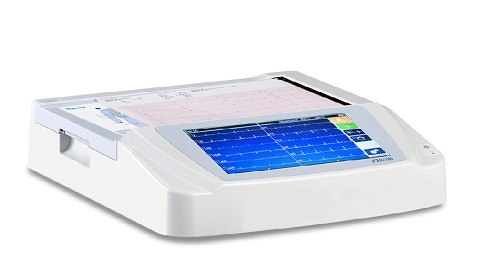
The Mortara Burdick ELI 280 is a compact, portable and lightweight electrocardiograph. It is designed to meet the needs of high volume environments. It provides all the features and extensive functionality of the ELI 250C with the added convenience and utility of a 10.1-inch high-resolution interpretive LCD touchscreen display. Additionally, it is capable of storing 200 records. It can be equipped with an optional wireless module that eliminates the need to be tethered to the patient with a cable. As with the ELI 250C it comes with the “Best 10” feature that selects and displays the best 10 seconds of data from the memory automatically. The list cost for the ELI 280 is $4900 but can be purchased for around $4000.
● Burdick ELI 230 Resting 12-Lead ECG Machine Interpretive

The Burdick ELI 230 is a compact, easy-to-use portable machine that provides cost-effective yet comprehensive functionality. It comes standard with a high-resolution color display (320 x 240 pixels) that provides real-time preview of 3, 8 or 12 leads of ECG data as well as post acquisition review of the acquired ECG. It is capable of storing 20 records. As with its more expensive siblings, the ELI 230 comes standard with “Best 10” data acquisition, pediatric and neonate interpretation, high data acquisition speed (40,000 sps per channel) and is available in with AM 12 Acquisition Module or Wireless Acquisition Module (WAM). The list price for this ECG device is around $1,800 but can be purchased for less.
Schiller CARDIOVIT FT-1 Tablet ECG Machine
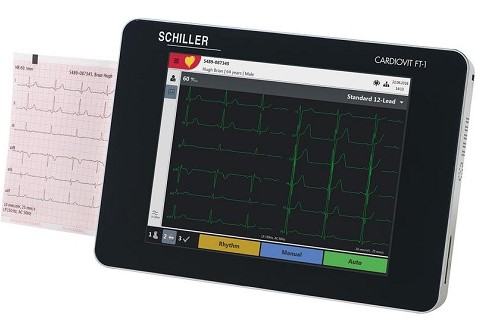
The latest ECG machine from SCHILLER is an ultra portable tablet 12-lead ECG machine with an 8" high-resolution multi-touch screen and integrated thermal printer. This ECG machine features the latest in Wi-Fi connectivity providing for wireless connectivity to EMR systems. The CARDIOVIT FT-1 features an anatomical hook up adviser that helps to place the electrodes in the correct position and it provides warnings if the ECG leads are reversed. This tablet ECG machine comes with interpretation software and can be use for adult ECGs and pediatric ECGs.
● Welch Allyn CP 50 Resting ECG Machine with Optional Interpretive And Connectivity
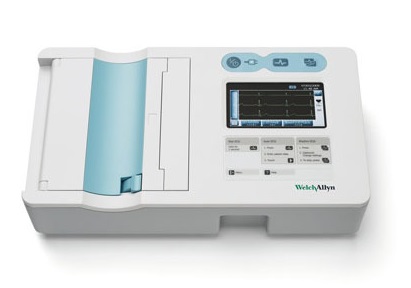
The Welch Allyn ECG Machine, model CP 50, offers speed, simplicity and multiple connectivity features at an affordable price. ECG readings are initiated with the touch of a button. The CP 50 has a flexible range of connectivity features to send, manage, and share patient data with other systems inside or outside of your facility. The system comes standard with a high-resolution thermal printer, battery operation, internal storage, and optional interpretation. Pricing information can be provided by inquiry by calling 888-215-0718.
12-Lead ECG machine with spirometry
Some ECG/EKG machines are equipped with or can be upgraded with spirometry instrumentation. Spirometry is a common medical test to evaluate how well the lungs work by measuring the volume of air that is inhaled, exhaled and how quickly air is exhaled. Spirometry is used to diagnose asthma, COPD, and other breathing disorders.
● Schiller Resting ECG Machine Cardiovit AT-2 plus ECG Spirometry
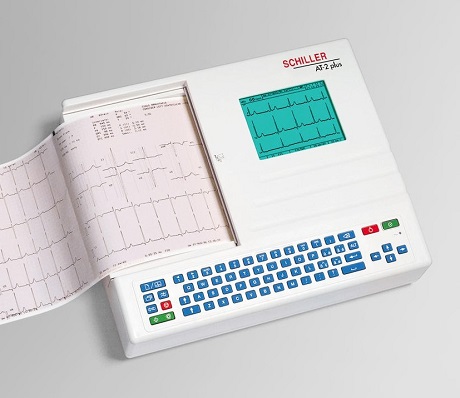
Schiller was the first manufacturer to combine the two most common pulmonary and cardiac tests in one device– the CARDIOVIT AT-2 Plus with ECG and spirometry function. It is a 12-Lead ECG machine with an optional spirometry upgrade. It features a large high-resolution backlit monitor and integrated high-resolution printer. Repeat recordings are not needed with Schiller’s smoothing and baseline filters. This device is capable of storing up to 40 patients. The list price for this Schiller EKG Machine is $2,850 but it can be purchased for around $2,600.
● Schiller Resting ECG Machine AT-102 Plus ECG with Spirometry
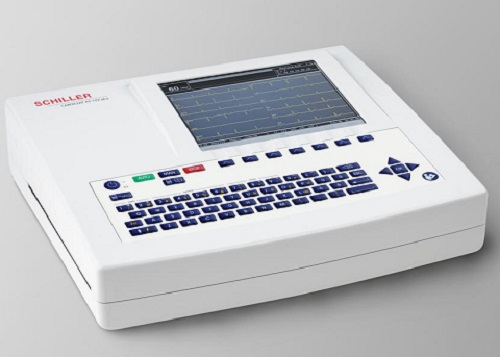
The Schiller AT-102 Plus ECG machine is a 12-Lead device with optional spirometry upgrades. It is also upgradable with an optional interpretation program that offers comprehensive computer-based analysis. It comes standard with a lithium-polymer battery that provides up to three hours of battery use. It also features an 8.4-inch TFT color screen (800 x 600 dpi). Wireless connections are possible via standard connectivity protocols. List price for the AT-102 is $3,995 but can be purchased for hundreds less.
● Schiller CARDIOVIT AT-10 Resting ECG Machine with optional Spirometry
S

The Schiller CARDIOVIT AT-1O Plus provides all the functions of a high-quality 12-channel electrocardiograph and meets the requirements of an integrated diagnostic workstation. The CARDIOVIT AT-1O Plus combines resting ECG, exercise ECG, pacemaker measurement, HRV analysis, signal averaged ECG analysis, thrombolysis software and spirometry in a single system. Three models are available with upgrades including spirometry and wireless connectivity. It features a built-thermal printer and high-resolution 10.4-inch TFT color screen. The manufacturer’s list price for the Cardiovit AT-10 is $6,795 but it can be purchased for less.
● Welch Allyn CP 150 Resting ECG Machine with Optional Spirometry
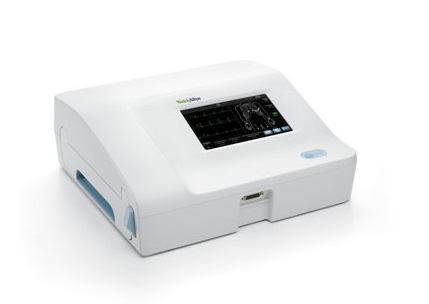
The Welch Allyn CP 150 Resting Electrocardiograph (ECG) with optional spirometry combines the traditional ECG features like full-size printouts and clinical decision with a touchscreen interface, one-button operation, and flexible connectivity options. When used with the optional spirometry module, the CP 150 is capable of performing two tests with one device. The Welch Allyn CP 150 features a 7-inch touch-screen display, battery operation, storage of up to 100 test results, and connectivity via USB and Ethernet. ECG reports can be reviewed prior to printing reducing paper supply costs. The CP 150 is listed for $4,600 and can be purchased for considerably less.
Stress ECG Machines
A stress test can be helpful in discovering heart disease. These stress tests, also known as exercise tests, are performed while walking on a treadmill or pedaling a stationary bike. The ECG, heart rate and blood pressure are tracked.
● Schiller Cardiovit AT-10 Stress ECG Machine with Treadmill

This is the same Schiller Cardiovit AT-10 system previously described. This equipment configuration is upgraded to include a high quality medical treadmill. The low-profile treadmill has a weight capacity of 500 pounds. The treadmill has been designed to be highly accurate and self-calibrating for speed and elevation. It is available in 110v and 220v models. This bundle lists for $8,395 but can be purchased at a significant discount.
● Schiller Cardiovit CS-200 ECG Machine with Treadmill

The Schiller Cardiovit CS-200 is a 12-Lead resting ECG bundled with a high quality medical treadmill for stress testing. It features automatic ECG measurements and interpretation for adults and children. It has a fully integrated data management systems and connectivity to network systems. It comes standard with spirometry and resting rhythm recording. This machine is suitable for small practices as well as high volume stress labs. It comes with a suggested price tag of $15,995 but can be purchased at a sizable discount.
Holter Wearable ECG Monitor
A Holter ECG monitor is a highly portable ECG machine that measures and records heart activity. It is wearable and battery operated. It is used to continuously record heart function for 24 to 48 hours, sometimes longer. This small ECG machine is about the size of a small camera. It comes equipped with wires with silver dollar-sized electrodes that attach to the skin. The Holter monitor is an ambulatory electrocardiogram.
● Mortara Burdick 4250 Holter Recorder Kit
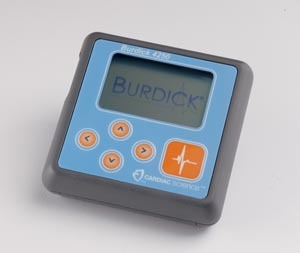
The Burdick 4250 Digital Holter Recorder provides high-quality 5- or 7-lead, 3-channel Holter recordings with a signal preview screen. This device provides fast data transfer using an SD card or USB cable. It features an integrated LCD display and will verify signal quality before the patient leaves for home. The Burdick 4250 can be tucked into a pocket or easily hidden under clothing.
Need to measure other vital signs? Check out our Vital Signs Monitor Buyer's Guide.
ECG Machine Accessories and Supplies
All ECG/EKG machines need supplies. Many need additional accessories to achieve optimum functionality. These include ECG electrodes, ECG cables, prep gels, graph paper (ECG paper), ECG carts and many more. Your preferred ECG equipment vendor will be able to supply everything you need.
How to maintain ECG Machines
ECG machines should be regularly cleaned and maintained. A few simple steps will keep machines running well and lasting a long time.
- After daily use, electrodes should be cleaned. If copper alloy electrodes become rusted, fine sandpaper will remove the rust after soaking overnight in a saline solution. Silver-plated electrodes can be gently wiped clean with water to avoid damaging the surface.
- Lead wires can break or be easily damaged near connections. Avoid pulling or twisting with too much force. Check connections often.
- Battery operated ECG machines should be charged daily.
- Avoid heat, moisture, dust or shock. Store with dust cover if possible.
- Open the device every six months and remove dust with a can of compressed air. If used in high humidity environments, circuit boards can be dried with a household blow dryer set on low or no heat.
- Follow manufacturer instructions regarding service.
- Instructions for how to calibrate ECG machines will be provided by the manufacturer. Regular calibration is essential to ensure accurate readings.
Where to Buy an ECG Machine
Be sure to choose a hospital and medical equipment supplier that you can trust. Very few companies can match the expert service, wide selection and pricing provided by USA Medical and Surgical Supplies.
Looking for an EKG Machine for Sale?
The ECG/EKG is one of the most important inventions and most useful tools in modern medicine. Medical and Surgical Centers use ECG machines because they are non-invasive and quickly administered. Patients experiencing chest pain or are thought to be experiencing a heart attack can easily be monitored and evaluated by using an electrocardiogram.
With a wide range of options, medical and surgical centers can choose an ECG machine with specific capabilities, configurations and options.
For more information regarding your specific needs and available discounts, contact the experts at USA Medical on our Contact form or call 1-866-561-2380.




